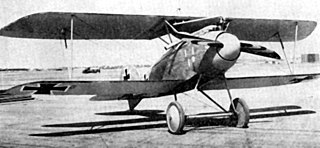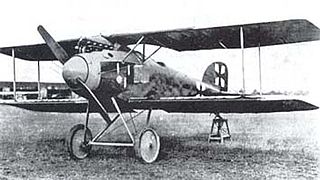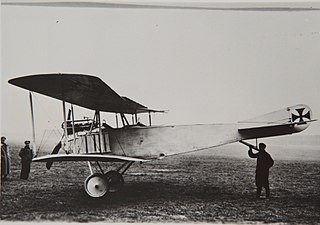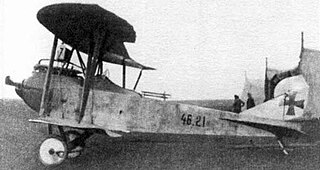Related Research Articles

The Hansa-Brandenburg B.I was an unarmed military trainer and reconnaissance biplane of World War I, flown by the Austro-Hungarian Air Service. Early models were known internally to the Hansa-Brandenburg firm as the type D, while later models with a more powerful engine were designated FD. This aircraft was one of the earliest designs of Ernst Heinkel, who was working for Hansa-Brandenburg at the time. It was an entirely conventional two-bay biplane with staggered wings of unequal span. The pilot and observer sat in tandem in a long open cockpit.

The Albatros D.III was a biplane fighter aircraft used by the Imperial German Army Air Service (Luftstreitkräfte) during World War I. A modified licence model was built by Oeffag for the Austro-Hungarian Air Service (Luftfahrtruppen). The D.III was flown by many top German aces, including Wilhelm Frankl, Erich Löwenhardt, Manfred von Richthofen, Karl Emil Schäfer, Ernst Udet, and Kurt Wolff, and Austro-Hungarian ones, like Godwin von Brumowski. It was the preeminent fighter during the period of German aerial dominance known as "Bloody April" 1917.

The Albatros D.II was a German fighter aircraft used during World War I. After a successful combat career in the early Jagdstaffeln, it was gradually superseded by the Albatros D.III.

The Fokker D.I was a development of the D.II fighter. The D.I was also flown in Austro-Hungarian service as a fighter trainer aircraft under the designation B.III. Confusing the matter further, both the D.II and D.I arrived at the Front in German service at similar times, in July–August 1916. The main designer was Martin Kreutzer.

The Albatros B.I, was a German military reconnaissance aircraft designed in 1913 and which saw service during World War I.

The Fokker M 10 was a two-seater reconnaissance / fighter-trainer biplane with single-bay wings equipped with wing-warping controls for roll, powered by a 7-cylinder 80 hp Oberursel U.0 engine. Several M 10 aircraft were purchased by the Imperial and Royal Aviation Troops of Austro Hungary.

The Hansa-Brandenburg C.I, also known as Type LDD, was a 2-seater armed single-engine reconnaissance biplane designed by Ernst Heinkel, who worked at that time for the parent company in Germany. The C.I had similarities with the earlier B.I, including inward-sloping interplane bracing struts. Like other early-war Austro-Hungarian reconnaissance aircraft, such as C-types of Lloyd or Lohner, the Type LDD had a communal cockpit for its crew.

The Lohner L was a reconnaissance flying boat produced in Austria-Hungary during World War I. It was a two-bay biplane of typical configuration for the flying boats of the day, with its pusher engine mounted on struts in the interplane gap. The pilot and observer sat side by side in an open cockpit, and both the upper and lower sets of wings featured sweepback.
The Aviatik (Berg) D.II, the prototypes of which were known as Aviatik 30.22 and Aviatik 30.38, was an Austro-Hungarian fighter plane prototype towards the end of the First World War.

The Albatros B.III,, was a German World War I reconnaissance biplane, built by Albatros Flugzeugwerke as the Albatros LDD.
The Knoller C.I was a reconnaissance aircraft built in Austria-Hungary during World War I for use by the Austro-Hungarian army. It was a conventional biplane design with staggered wings, and seated the pilot and observer in tandem in an open cockpit. The upper wing was swept back.

The Lloyd C.II and its derivatives, the C.III and C.IV were reconnaissance aircraft produced in Austria-Hungary during the First World War. They were based on the Lloyd company's pre-war C.I design, and like it, were conventional biplanes with swept-back wings.

The Lloyd C.V was a reconnaissance aircraft produced in Austria-Hungary during the First World War. It was a departure from Lloyd's previous reconnaissance types, which had all been based on a pre-war design. The C.V was a more compact and streamlined aircraft with an unusual wing structure.

The Lohner B.I was a military reconnaissance aircraft produced in Austria-Hungary during World War I. As Lohner strove to perfect the design, a variety of increasingly powerful engines were fitted, reflected in a range of military designations from B.II through to B.VI until the definitive B.VII was finally produced. This last version was also produced in an armed variant, designated the C.I.

The Lohner B.II was a military reconnaissance aircraft produced in Austria-Hungary during World War I. It was a development of the pre-war B.I design, incorporating changes requested by the Austro-Hungarian army, but inheriting its predecessor's basic design, including its characteristic swept-back wings.

The unarmed Lohner B.VII and its armed derivative the C.I were military reconnaissance aircraft produced in Austria-Hungary during World War I. They were the ultimate developments in a family of aircraft that had begun with the B.I prior to the outbreak of war, and were the first members of that family that proved suitable for front-line service during the conflict. Like their predecessors, the B.VII and C.I were conventional biplanes with characteristic swept-back wings.

The Phönix C.I, given serial numbers in the Phönix 121 range, was an Austro-Hungarian First World War reconnaissance and general-purpose Biplane built by Phönix and Lloyd.
The Oeffag G , sometimes known as the Oeffag Type G or Oeffag-Mickl G, was a three-engined reconnaissance flying boat built in Austria during the First World War and deployed by the Kaiserlich und Königlich Seefliegerkorps.

The Oeffag C.II was a military reconnaissance aircraft produced in Austria-Hungary during World War I.
The Halberstadt C.VIII was a prototype two-seat general-purpose biplane built by Halberstadt during World War I.